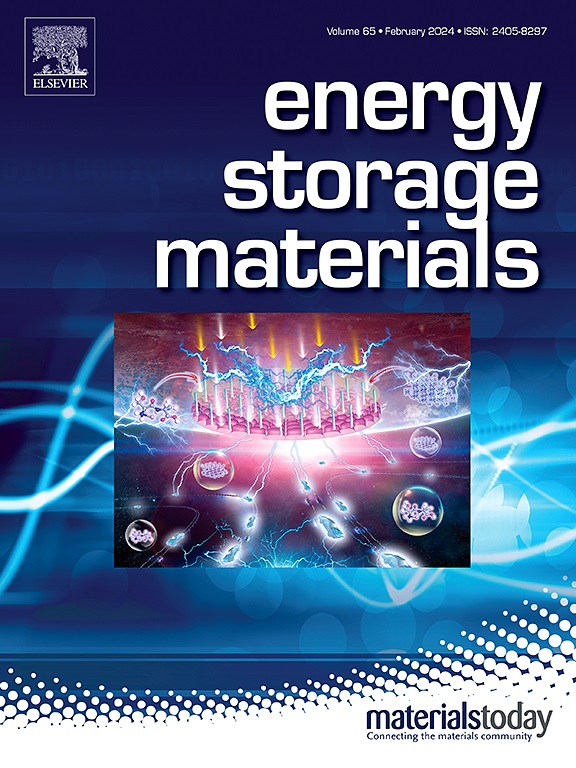Understanding and Mitigating Acidic Species in All-Fluorinated Electrolytes for a Stable 572 Wh/kg Lithium Metal Battery (LMB)
IF 18.9
1区 材料科学
Q1 CHEMISTRY, PHYSICAL
引用次数: 0
Abstract
Fluorine-rich electrolytes hold promise to significantly enhance the energy and the safety of lithium metal batteries (LMBs). However, they generate acidic species, especially when lithium hexafluorophosphate (LiPF6) is used as the lithium salt. This critical issue impedes their wide-scale utilization but has to date received minimum analysis. Herein, we reveal the mechanisms behind the exacerbation of HF generation in LiPF6-based all-fluorinated electrolytes and propose a universally applicable mitigation strategy. The screened additive Tris(trimethylsilyl)phosphate (TMSPa) reacts with HF and stabilizes PF5, preventing its further hydrolysis and thereby effectively reducing the HF content in fluorine-rich electrolytes. TMSPa contributes to preferentially form a conductive and protective solid electrolyte interphase (SEI), suppressing interface parasitic reactions and ensuring the structural integrity of electrode materials throughout battery cycling. The all-fluorinated electrolytes developed in this work with the addition of TMSPa (AFE-TMSPa) demonstrates a wide electrochemical window (4.6 V), high-temperature stability (up to 55°C), and enhanced safety for LMBs (flame-retardant and dendrite-suppressing). A Li metal pouch cell (7.2 Ah) employing AFE-TMSPa (NCM811 double sided cathode with a mass loading of 80.72 mg/cm2), and lean electrolytes at 1.23 g Ah−1, achieves an energy density of 572 Wh kg−1 at a 0.1 C rate. In a Li||NCM811 coin cell with a 50 µm thick Li-metal anode and a high-loading NCM811 cathode (19.8 mg cm−2, 3.96 mAh cm−2), the system supports 160 stable cycles with a capacity retention of 89% at a 0.2 C charge and 0.5 C discharge rate.

572 Wh/kg稳定锂金属电池(LMB)对全氟电解液酸性物质的认识和缓解
富氟电解质有望显著提高锂金属电池(lmb)的能量和安全性。然而,它们会产生酸性物质,特别是当六氟磷酸锂(LiPF6)被用作锂盐时。这一关键问题阻碍了它们的大规模利用,但迄今为止得到的分析很少。在此,我们揭示了在基于lipf6的全氟电解质中HF生成加剧的机制,并提出了一种普遍适用的缓解策略。筛选出的添加剂Tris(trimethylsilyl)phosphate (TMSPa)与HF发生反应,稳定PF5,防止其进一步水解,从而有效降低富氟电解质中HF的含量。TMSPa有助于优先形成导电和保护性的固体电解质界面相(SEI),抑制界面寄生反应,并确保电池循环过程中电极材料的结构完整性。在本研究中,添加TMSPa (AFE-TMSPa)的全氟化电解质具有宽的电化学窗口(4.6 V),高温稳定性(高达55°C),并且增强了lmb(阻燃和抑制枝晶)的安全性。采用AFE-TMSPa(质量负载为80.72 mg/cm2的NCM811双面阴极)和1.23 g Ah−1的贫电解质的锂金属袋状电池(7.2 Ah),在0.1 C速率下获得了572 Wh kg−1的能量密度。在Li||NCM811硬币电池中,具有50 μ m厚的锂金属阳极和高负载NCM811阴极(19.8 mg cm - 2, 3.96 mAh cm - 2),该系统支持160个稳定循环,在0.2 C充电和0.5 C放电速率下容量保持率为89%。
本文章由计算机程序翻译,如有差异,请以英文原文为准。
求助全文
约1分钟内获得全文
求助全文
来源期刊

Energy Storage Materials
Materials Science-General Materials Science
CiteScore
33.00
自引率
5.90%
发文量
652
审稿时长
27 days
期刊介绍:
Energy Storage Materials is a global interdisciplinary journal dedicated to sharing scientific and technological advancements in materials and devices for advanced energy storage and related energy conversion, such as in metal-O2 batteries. The journal features comprehensive research articles, including full papers and short communications, as well as authoritative feature articles and reviews by leading experts in the field.
Energy Storage Materials covers a wide range of topics, including the synthesis, fabrication, structure, properties, performance, and technological applications of energy storage materials. Additionally, the journal explores strategies, policies, and developments in the field of energy storage materials and devices for sustainable energy.
Published papers are selected based on their scientific and technological significance, their ability to provide valuable new knowledge, and their relevance to the international research community.
 求助内容:
求助内容: 应助结果提醒方式:
应助结果提醒方式:


